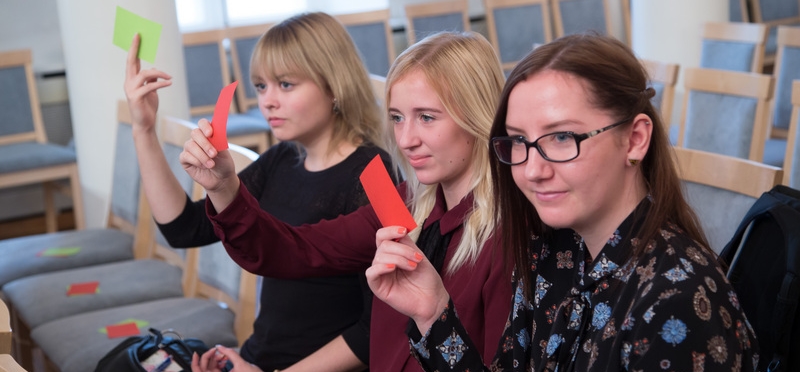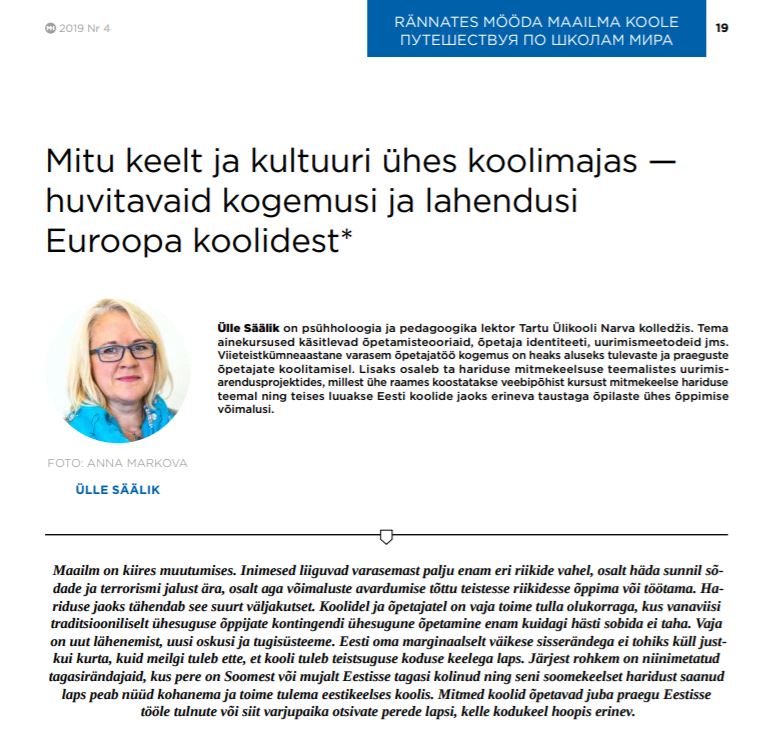- Home
- Study book
- Week 1: Introduction to multilingualism and plurilingualism
- Week 2: Understanding bilingualism
- Week 3: Multilingualism in state and society, and the role of communities
- Week 4: Early Childhood Multilingualism
- Week 5: Multilingual school
- Week 6: Multilingual higher education
- Week 7: Interculturalism and intercultural communication
- Course team

MOOC: Multilingual Education
Week 5 Pool of ideas for seminars
The readings, videos and activities below are designed to provide opportunities for deepening your knowledge about the topics covered in Week 5 of the MOOC (e-Course) “Multilingual schools”. It is aimed to be used in academic seminars, providing extra materials, some suggestions for activities, etc.
In order to become familiar with the basics of the topic, it is recommended that you go through the self-study e-Course as follows:
- To become familiar with the topic and concepts of multilingualism in schools, study the MOOC materials of Week 5 part 1 here: https://sisu.ut.ee/multilingual/book/2-content-and-language-integrated-learning-and-immersion
- Week 5 part 2 here: https://sisu.ut.ee/multilingual/book/1-multilingual-education
- Week 5 part 3 here: https://sisu.ut.ee/multilingual/book/3-language-support-multilingual-schools
- Complete the Week 5 quiz here:https://sisu.ut.ee/multilingual/multilingual-5
Extra materials for academic seminars or for individual learners wishing to deepen their understanding of the topic:
Module 5.1
May, Stephen (2017): Bilingual Education: What the Research Tells Us.
https://www.researchgate.net/publication/312266687_bilingual_education_what_the_research_tells_us.
The chapter presents aims of bilingual education and various approaches to teaching bilingual classes. It also includes recent research on prevailing forms of bilingual education. May furthermore addresses pedagogical implications for already existing bilingual programs.
Module 5.2
Selected Articles: Washington International School. AICE Newsletter (1999-2007):
https://www.wis.edu/uploaded/admissions/immersion.pdf
The collection of articles mainly deals with issues that parents are faced with in bilingual education and immersion. Pieces of writing from parents’ and empirical research reports to newspaper articles give insight into benefits of bilingual education and how parents may support their children.
The CLIL Guidebook:
https://www.languages.dk/archive/clil4u/book/CLIL%20Book%20En.pdf
The guidebook describes features of and reasons for implementation of CLIL. The 5Cs are reintroduced and theoretical background is also explained. Moreover, a variety of example lessons is described and accompanied by videos, which can be accessed through a list of links to YouTube. The question of evaluation is dealt with in addition to suggestions for practical use.
Videos Module 5.1 and/or 5.2
Check the links! Videos not available!!
The Casey Middle School in Boulder, CO, USA has a very diverse student population with about 45% Spanish speaking children. They offer a bilingual program for those students who are native Spanish speakers and native English speakers wanting to learn Spanish. Progress is sought in both languages. Over the course of three years, different subjects are taught in Spanish or English alternately. Students tutor each other in tandems which facilitates cross-cultural communication.
Claremont Immersion School (Elemantary school) in Arlington, VA, USA has a large Spanish speaking student body. Various methods and approaches define the staff’s work: extra support for students who learn on different levels, team teaching and group work is implemented on a regular basis.
Six videos demonstrating CLIL used in classes from primary schools and vocational colleges (CLIL4U) – full version
Module 5.3
Multilingual Families: Activities to support Multilingualism at school.
https://skolapelican.com/wp-content/uploads/2015/05/Activities-to-support-multilingualism-at-school.pdf
A brochure that presents 26 activities created for the multilingual classroom. The activities are designed to motivate the students to gain interest in other languages while being enjoyable at the same time. They are suitable mainly for kindergarten and primary classes and cover different content and competences.
“Agree-disagree”- activity for the seminar: Myths or facts about language immersion and learning in a foreign/other/second language?
Instructions:
The professor leading the seminar can decide how to organize this activity:
Option 1: Learners stand in line as a scale, one end “true/fact” and the other end “myth/false”, then people having rather similar opinion are having a short discussion why they decided so, and a whole group discusson follows, in which diversity of opinions is accepted and argumentations are encouraged.
Option 2: Learners show their opinion with their hand, hand high up “true/fact” and hand down as low as possible “myth/false, people will have a change to express their opinion and reasons behind it, a whole group discussion follows, in which diversity of opinions is accepted and argumentations are encouraged.
The professor says: Hear the statements. Decide whether they are facts proved by researches, or are they myths, false beliefs which have not been found plausible in the relevant studies.
-
Only very gifted children can successfully cope with learning in a second language.
Fact/True Myth/False -
Learners of language immersion programmes understand both cultures better.
Fact/True Myth/False -
Children have difficulties with studies because their parents cannot help them as they do not know the language of instruction.
Fact/True Myth/False -
Comprehension and acquisition of subject knowledge in a second language is much more complicated.
Fact/True Myth/False -
In language immersion classes the learners acquire the same knowledge as in a mainstream schools, but with the addition of second language acquisition at a higher level.
Fact/True Myth/False -
Children grow up to become, so to say, “half-language” people, as they neither know their mother tongue nor the target language.
Fact/True Myth/False
Follow-up dicsussion: Where do the myths come from and what to do about it?
Languages around us: How to use our surroundings for more meaningful language acquisition?
The aim of this seminar activity is to acknowledge, how every educator could take advantage of the surroundings for better and more meaningful language acquisition, including content and language integrated learning (CLIL).
For example, taking the learners ourtside to the classrooms, to class trips, animal parks, museums etc. could be turned into a useful language learning experience by preparing certain tasks for it, e.g. a booklet with a variety of tasks, questions, which would draw learners’ attention to the language that appears on their way (information boards etc.).
One sample booklet (nature and language integrated learning) is added, and it could be used for discussion with learners: [[{“fid”:”39752″,”view_mode”:”default”,”type”:”media”,”attributes”:{“height”:”722″,”width”:”1042″,”style”:”width: 242px; height: 168px; float: right;”,”alt”:”Image of the sample worksheet booklet”,”title”:”Capture of the sample worksheet booklet of the integrated learning “Animal park””,”class”:”media-element file-default”}}]]
- What kind of different tasks could you find in this booklet? Why are there different kinds of tasks? What are they for?
- Why is it in form of discovery learning (learner knows all the tasks at the beginning of the trip, but chooses when to solve which one or when this information appears)?
- What is the main aim – the accuracy of the language or widening the repertoire?
- Which modifications could be done with such task? Please, give reasons.
Учим язык в тандеме. Learning a language in a tandem. Õpime keelt tandemis. / Teaching in tandem.
The article 1 presents ideas of teaching languages and having two teachers in the classroom at the same time. The article is in Russian.
The article 2 presents one teacher’s experience with teaching English in tandem. The article is in English.
Questions for discussion in the seminar:
- What are good sides, what are the down sides of teaching together with another teacher?
- How could the issues be prevented?
1) RU ОЛЬГА БУРДАКОВА НИНА РАУД (2017). Учим язык в тандеме. Mitmekeelne haridus nr 1, pp 22 – 23 https://www.narva.ut.ee/sites/default/files/nc/mitmekeelne_h_2017_1_web.pdf
2) Teaching in tandem. , https://www.languagemagazine.com/teaching-in-tandem/
Mitu keelt ja kultuuri ühes koolimajas — huvitavaid kogemusi ja lahendusi Euroopa koolidest (Many languages and cultures in a schoolhouse – interesting know-how and solutions in some schools in Europe)
Europe)
The article presents some examples of how it is possible to have different langauges and cultures jointly in the same schoolhouse (which, as it turns out, is considered a mission impossible in some countries). The article is in the Estonian language. The English version on similar topic will be published in… in Autumn 2019.
EE Ülle Säälik (2019). Mitu keelt ja kultuuri ühes koolimajas — huvitavaid kogemusi ja lahendusi Euroopa koolidest. Mitmekeelne haridus nr 4, https://www.narva.ut.ee/sites/default/files/nc/mitm_04_web_2.pdf
Living together in a multicultural environment/ ZAmedkulturno sobivanje
Watch the interview (in Slovenian) with dr. Sonja Rutar of the University of Primorska, Slovenia, on the difficulties faced by children who move to other linguistic and cultural environments and the role of school in supporting their integration. Discuss the main difficulties of children and adolescents who find themselves in a completely different cultural and linguistic context. Do you personally know anybody with a similar experience?
Video: https://www.youtube.com/watch?v=upr_pJGG1rQ&feature=youtu.be


